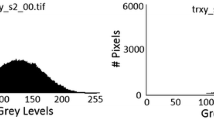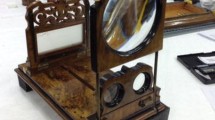Abstract
We develop a computational model for binocular stereopsis, attempting to explain the process by which the information detailing the 3-D geometry of object surfaces is encoded in a pair of stereo images. We design our model within a Bayesian framework, making explicit all of our assumptions about the nature of image coding and the structure of the world. We start by deriving our model for image formation, introducing a definition of half-occluded regions and deriving simple equations relating these regions to the disparity function. We show that the disparity function alone contains enough information to determine the half-occluded regions. We use these relations to derive a model for image formation in which the half-occluded regions are explicitly represented and computed. Next, we present our prior model in a series of three stages, or “worlds,” where each world considers an additional complication to the prior. We eventually argue that the prior model must be constructed from all of the local quantities in the scene geometry-i.e., depth, surface orientation, object boundaries, and surface creases. In addition, we present a new dynamic programming strategy for estimating these quantities. Throughout the article, we provide motivation for the development of our model by psychophysical examinations of the human visual system.
Similar content being viewed by others
References
Anderson, B. 1992. Personal communication. Technical Report. Harvard University.
Baker, H. and Binford, T. 1981. Depth from edge and intensity based stereo. In IJCAI, pp. 631–636.
Belhumeur, P. 1993. A Bayesian Approach to the Stereo Correspondence Problem. Ph.D. thesis, Harvard University.
Belhumeur, P. and Mumford, D. 1992. A Bayesian treatment of the stereo correspondence problem using half-occluded regions. In IEEE Proc. Conf. Computer Vision and Pattern Recognition, pp. 506–512.
Besag, J. 1974. Spatial interaction and statistical analysis of lattice systems. J. Roy. Stat. Soc. Lond. B., 36:192–225.
Blake, A. and Zisserman, A. 1987. Visual Reconstruction. MIT Press: Cambridge, USA.
Bulthoff, H., Fahle, M., and Wegmen, M. 1991. Disparity gradients and depth scaling. Perception 20, pp. 145–153.
Cernuschi-Frias, B., Belhumeur, P., and Cooper, D. 1985. Estimating and recognizing parameterized 3-D objects using a moving camera. In Proc. Conf. Computer Vision and Pattern Recognition, pp. 167–171.
Cernuschi-Frias, B., Cooper, D., Hung, Y., and Belhumeur, B. 1989. Toward a model-based Bayesian theory for estimating and recognizing parameterized 3-D objects using two or more images taken from different positions. IEEE Trans. Pattern Analysis and Machine Intelligence, pp. 1028–1052.
Clark, J. and Yuille, A. 1990. Data Fusion for Sensory Information, Kluwer Academic Press: Boston.
Cochran, S. and Medioni, G. 1992. 3-D Surface Description from Binocular Stereo. IEEE Trans. Pattern Analysis and Machine Intelligence, pp. 981–994.
Cohen, F., Cooper, D., Silverman, J., and Hinkle, E. 1984. Simple parallel hierarchical relaxation algorithms for segmenting textured images based on noncausal Markovian random field models. In Proc. Int. Conf. on Pattern Recognition, Montreal, Canada, pp. 1104–1107.
Cox, I.J., Hingorani, S., Maggs, B.M., and Rao, S.B. 1992. Stereo without disparity gradient smoothing: A Bayesian sensor fusion solution. In D. Hogg and R. Boyle, (eds.) British Machine Vision Conference. Springer-Verlag, pp. 337–346.
Cross, G. and Jain, A. 1983. Markov random field texture models. IEEE Trans. Pattern Analysis and Machine Intelligence, 5:25–39.
Geiger, D. and Girosi, F., Parallel and deterministic algorithms from MRF's: Surface reconstruction, IEEE Trans. Pattern Analysis and machine Intelligence, 13(5):401–412.
Geiger, D., Ladendorf, B., and Yuille, A. 1992. Occlusions in binocular stereo. In Proc. European Conf. on Computer Vision, Santa Margherita Ligure, Italy.
Geman, S. and Geman, D. 1984. Stochastic relaxation, Gibbs distribution and the Bayesian restoration of images. IEEE Trans. Pattern Analysis and machine Intelligence, 6:721–741.
Gennery, D. 1980. Modelling the Environment of an Exploring Vehicle by Means of Stereo Vision, Ph.D. thesis, Stanford University.
Grenander, U. 1981. Lectures on Pattern Theory, Springer-Verlag.
Grimson, W. 1981. From Images to Surfaces. MIT Press: Cambridge, USA.
Harris, J. 1989. The coupled depth/slope approach to surface reconstruction. Technical Report, MIT AI Lab Memo TR-908, MIT, Cambridge.
Henderson, R., Miller, W., and Grosch, C. 1979. Automatic stereo recognition of man-made targets. Soc. Photo-Optical Instrumentation Engineers.
Intille, S. and Bobick, A. 1994. Disparity-space images and large occlusion stereo. In Proc. European Conf. on Computer Vision, pp. 179–186.
Jones, D. and Malik, J. 1992. A computational framework for determining stereo correspondence from a set of linear spatial filters. In Proc. European Conf. on Computer Vision, Santa Margherita Ligure, Italy.
Julesz, B. 1971. Foundations of Cyclopean Perception. University of Chicago Press.
Kato, Z., Berthod, M., and Zerubia, J. 1993. Multiscale markov random field models for parallel image classification. In Proc. Int. Conf. on Computer Vision, pp. 253–257.
Lawson, R. and Gulick, W. 1967. Stereopsis and anomalous contour, Vision Research, 7:271–291.
Leonardo da Vinci 1989. Leonardo On Painting. Yale University Press: Kemp, M. (Ed.).
Lucas, B. and Kanade, T. 1981. An interative image registration technique with an application to stereo vision. In Proc. of the 7th International Joint Conference on Artificial Intelligence, pp. 674–679.
Marr, D. 1982. Vision. Freeman: San Francisco
Marr, D. and Poggio, T. 1976. Cooperative computation of stereo disparity, Science, 194: 283–287.
Marr, D. and Poggio, T. 1979. A computational theory of human stereo vision. Proc. R. Soc. London, 204:301–328.
Marroquin, J., Mitter, S., and Poggio, T. 1987. Probabilistic solutions of ill-posed problems in computational vision. J. of the Am. Stat. Soc., 82(397):76–89.
Matthies, L. 1992. Stereo vision for planetary rovers: Stochastic modeling to near real-time implementation. In Journal of Computer Vision, 8(1):71–91.
Mumford, D. and Shah, J. 1985. Boundary detection by minimising functionals. In Proc. Conf. Computer Vision and Patter Recognition, Vol. 22.
Nakayama, K. and Shimojo, S. 1980. Da Vinci stereopsis: Depth and subjective occluding contours from unpaired image points. Vision Research, 30:1811–1825.
Obta, Y. and Kanade, T. 1985. Stereo by intra- and inter-scan line search using dynamic programming. IEEE Trans. Pattern Analysis and Machine Intelligence, 7(2):139–154.
Poggio, T., Torre, V., and Koch, C. 1985. Computational vision and regularisation theory. Nature, 317:314–319.
Pollard, S., Mayhew, J., and Frisby, J. 1985. PMF: A stereo correspondence algorithm using a disparity gradient. Perception, 14:449–470.
Szeliski, R. 1989. A Bayesian Modeling of Uncertainty in Low-level Vision, Kluwer Academic Press: Boston.
Wahba, G. 1990. Spline models for observational data. In CBMS-NSF, Regional Conference Series in Applied Mathematics, Philadelphia.
Wildes, R. 1991. Direct recovery of three-dimensional scene geometry from binocular stereo disparity: IEEE Trans. Pattern Analysis and Machine Intelligence, pp. 761–774.
Yang, Y., Yuille, A., and Lu, J. 1993. Local, global, and multilevel stereo matching. In Proc. Conf. Computer Vision and Pattern Recognition, New York.
Yuille, A. 1989. Energy functions for early vision and analog networks. Biological Cybernetics, 61:115–123.
Zhang, Z. and Faugeras, O. 1992. 3-D Dynamic Scene Analysis: A Stereo Based Approach, Springer-Verlag: Berlin.
Zhang, Z., Deriche, R., Luong, L.T., and Faugeras, O. 1994. A robust approach to image matching: Recovery of the epipolar geometry. In Proc. European Conf. on Computer Vision, pp. 179–186.
Author information
Authors and Affiliations
Rights and permissions
About this article
Cite this article
Belhumeur, P.N. A Bayesian approach to binocular steropsis. Int J Comput Vision 19, 237–260 (1996). https://doi.org/10.1007/BF00055146
Received:
Accepted:
Issue Date:
DOI: https://doi.org/10.1007/BF00055146




